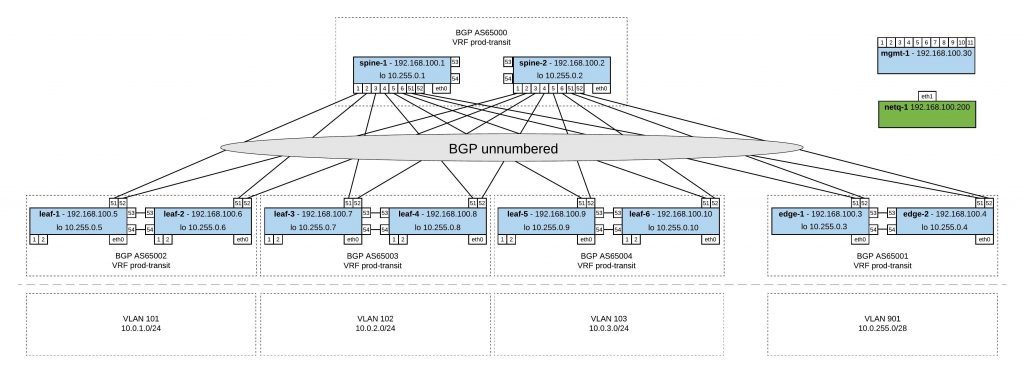After creating IOSv and IOS XE Vagrant images, now doing the same for Cisco ASAv. Like in my last post same basic idea to create an simulated on-demand network environment for continuous integration testing.
You need to buy the Cisco ASAv to get access to the KVM image on the Cisco website!
The Cisco ASAv is pretty easy because you can get QCOW2 images directly on the Cisco website, there are a few changes you need to do before you can use this together with Vagrant.
Boot the ASAv QCOW2 image on KVM and add the configuration below:
conf t interface Management0/0 nameif management security-level 0 ip address dhcp no shutdown exit hostname asa domain-name lab.local username vagrant password vagrant privilege 15 aaa authentication ssh console LOCAL aaa authorization exec LOCAL auto-enable ssh version 2 ssh timeout 60 ssh key-exchange group dh-group14-sha1 ssh 0 0 management username vagrant attributes service-type admin ssh authentication publickey AAAAB3NzaC1yc2EAAAABIwAAAQEA6NF8iallvQVp22WDkTkyrtvp9eWW6A8YVr+kz4TjGYe7gHzIw+niNltGEFHzD8+v1I2YJ6oXevct1YeS0o9HZyN1Q9qgCgzUFtdOKLv6IedplqoPkcmF0aYet2PkEDo3MlTBckFXPITAMzF8dJSIFo9D8HfdOV0IAdx4O7PtixWKn5y2hMNG0zQPyUecp4pzC6kivAIhyfHilFR61RGL+GPXQ2MWZWFYbAGjyiYJnAmCP3NOTd0jMZEnDkbUvxhMmBYSdETk1rRgm+R4LOzFUGaHqHDLKLX+FIPKcF96hrucXzcWyLbIbEgE98OHlnVYCzRdK8jlqm8tehUc9c9WhQ==
Now the image is ready to use with Vagrant. Create an instance folder under the user vagrant directory and copy the QCOW2 image. As well create an metadata.json file:
mkdir -p ~/.vagrant.d/boxes/asav/0/libvirt/
cp ASAv.qcow2 ~/.vagrant.d/boxes/asav/0/libvirt/box.img
printf '{"provider":"libvirt","format":"qcow2","virtual_size":2}' > metadata.json
Create a Vagrantfile with the needed configuration and boot up the VMs. You have to start the VMs one by one.
berndonline@lab:~/asa-lab-vagrant$ vagrant status
Current machine states:
asa-1 not created (libvirt)
asa-2 not created (libvirt)
This environment represents multiple VMs. The VMs are all listed
above with their current state. For more information about a specific
VM, run `vagrant status NAME`.
berndonline@lab:~/asa-lab-vagrant$ vagrant up asa-1
Bringing machine 'asa-1' up with 'libvirt' provider...
==> asa-1: Creating image (snapshot of base box volume).
==> asa-1: Creating domain with the following settings...
==> asa-1: -- Name: asa-lab-vagrant_asa-1
==> asa-1: -- Domain type: kvm
==> asa-1: -- Cpus: 1
==> asa-1: -- Feature: acpi
==> asa-1: -- Feature: apic
==> asa-1: -- Feature: pae
==> asa-1: -- Memory: 2048M
==> asa-1: -- Management MAC:
==> asa-1: -- Loader:
==> asa-1: -- Base box: asav
==> asa-1: -- Storage pool: default
==> asa-1: -- Image: /var/lib/libvirt/images/asa-lab-vagrant_asa-1.img (8G)
==> asa-1: -- Volume Cache: default
==> asa-1: -- Kernel:
==> asa-1: -- Initrd:
==> asa-1: -- Graphics Type: vnc
==> asa-1: -- Graphics Port: 5900
==> asa-1: -- Graphics IP: 127.0.0.1
==> asa-1: -- Graphics Password: Not defined
==> asa-1: -- Video Type: cirrus
==> asa-1: -- Video VRAM: 9216
==> asa-1: -- Sound Type:
==> asa-1: -- Keymap: en-us
==> asa-1: -- TPM Path:
==> asa-1: -- INPUT: type=mouse, bus=ps2
==> asa-1: Creating shared folders metadata...
==> asa-1: Starting domain.
==> asa-1: Waiting for domain to get an IP address...
==> asa-1: Waiting for SSH to become available...
==> asa-1: Configuring and enabling network interfaces...
asa-1: SSH address: 10.255.1.238:22
asa-1: SSH username: vagrant
asa-1: SSH auth method: private key
asa-1: Warning: Connection refused. Retrying...
==> asa-1: Running provisioner: ansible...
asa-1: Running ansible-playbook...
PLAY [all] *********************************************************************
PLAY RECAP *********************************************************************
berndonline@lab:~/asa-lab-vagrant$ vagrant up asa-2
Bringing machine 'asa-2' up with 'libvirt' provider...
==> asa-2: Creating image (snapshot of base box volume).
==> asa-2: Creating domain with the following settings...
==> asa-2: -- Name: asa-lab-vagrant_asa-2
==> asa-2: -- Domain type: kvm
==> asa-2: -- Cpus: 1
==> asa-2: -- Feature: acpi
==> asa-2: -- Feature: apic
==> asa-2: -- Feature: pae
==> asa-2: -- Memory: 2048M
==> asa-2: -- Management MAC:
==> asa-2: -- Loader:
==> asa-2: -- Base box: asav
==> asa-2: -- Storage pool: default
==> asa-2: -- Image: /var/lib/libvirt/images/asa-lab-vagrant_asa-2.img (8G)
==> asa-2: -- Volume Cache: default
==> asa-2: -- Kernel:
==> asa-2: -- Initrd:
==> asa-2: -- Graphics Type: vnc
==> asa-2: -- Graphics Port: 5900
==> asa-2: -- Graphics IP: 127.0.0.1
==> asa-2: -- Graphics Password: Not defined
==> asa-2: -- Video Type: cirrus
==> asa-2: -- Video VRAM: 9216
==> asa-2: -- Sound Type:
==> asa-2: -- Keymap: en-us
==> asa-2: -- TPM Path:
==> asa-2: -- INPUT: type=mouse, bus=ps2
==> asa-2: Creating shared folders metadata...
==> asa-2: Starting domain.
==> asa-2: Waiting for domain to get an IP address...
==> asa-2: Waiting for SSH to become available...
==> asa-2: Configuring and enabling network interfaces...
asa-2: SSH address: 10.255.1.131:22
asa-2: SSH username: vagrant
asa-2: SSH auth method: private key
==> asa-2: Running provisioner: ansible...
asa-2: Running ansible-playbook...
PLAY [all] *********************************************************************
PLAY RECAP *********************************************************************
berndonline@lab:~/asa-lab-vagrant$ vagrant status
Current machine states:
asa-1 running (libvirt)
asa-2 running (libvirt)
berndonline@lab:~/asa-lab-vagrant$
After the VMs are successfully booted you can connect with vagrant ssh:
berndonline@lab:~/asa-lab-vagrant$ vagrant ssh asa-1 Type help or '?' for a list of available commands. asa# show version Cisco Adaptive Security Appliance Software Version 9.6(2) Device Manager Version 7.6(2) Compiled on Tue 23-Aug-16 18:38 PDT by builders System image file is "boot:/asa962-smp-k8.bin" Config file at boot was "startup-config" asa up 10 mins 31 secs Hardware: ASAv, 2048 MB RAM, CPU Xeon E5 series 3600 MHz, Model Id: ASAv10 Internal ATA Compact Flash, 8192MB Slot 1: ATA Compact Flash, 8192MB BIOS Flash Firmware Hub @ 0x0, 0KB .... Configuration has not been modified since last system restart. asa# exit Logoff Connection to 10.255.1.238 closed by remote host. Connection to 10.255.1.238 closed. berndonline@lab:~/asa-lab-vagrant$ vagrant destroy ==> asa-2: Removing domain... ==> asa-2: Running triggers after destroy... Removing known host entries ==> asa-1: Removing domain... ==> asa-1: Running triggers after destroy... Removing known host entries berndonline@lab:~/asa-lab-vagrant$
Here I have a virtual ASAv environment which I can spin-up and down as needed for automation testing.
The example Vagrantfile you can find in my Github repository:
https://github.com/berndonline/asa-lab-vagrant/blob/master/Vagrantfile
Read my new post about an Ansible Playbook for Cisco ASAv Firewall Topology
